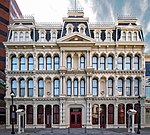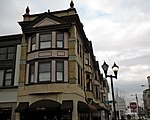Delaware Supreme Court
1841 establishments in DelawareCourts and tribunals established in 1841Delaware Supreme CourtDelaware state courtsState supreme courts of the United States

The Supreme Court of Delaware is the sole appellate court in the United States state of Delaware. Because Delaware is a popular haven for corporations, the Court has developed a worldwide reputation as a respected source of corporate law decisions, particularly in the area of mergers and acquisitions.
Excerpt from the Wikipedia article Delaware Supreme Court (License: CC BY-SA 3.0, Authors, Images).Delaware Supreme Court
North French Street, Wilmington
Geographical coordinates (GPS) Address Nearby Places Show on map
Geographical coordinates (GPS)
| Latitude | Longitude |
|---|---|
| N 39.743288 ° | E -75.546107 ° |
Address
Elbert N. Carvel Delaware State Building
North French Street 820
19801 Wilmington
Delaware, United States
Open on Google Maps








